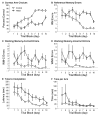Otoconia-deficient mice show selective spatial deficits
- PMID: 24802640
- PMCID: PMC4209000
- DOI: 10.1002/hipo.22300
Otoconia-deficient mice show selective spatial deficits
Abstract
The vestibular system contributes to the performance of various spatial memory tasks, but few studies have attempted to disambiguate the roles of the semicircular canals and otolith organs in this performance. This study tested the otolithic contribution to spatial working and reference memory by evaluating the performance of otoconia-deficient tilted mice on a radial arm maze and a Barnes maze. One radial arm maze task provided both intramaze and extramaze cues, whereas the other task provided only extramaze cues. The Barnes maze task provided only extramaze cues. On the radial arm maze, tilted mice performed similar to control mice when intramaze cues were available, but committed more working and reference memory errors than control mice when only extramaze cues were available. On the Barnes maze task, control and tilted mice showed similar latency, distance, and errors during acquisition training. On the subsequent probe trial, both groups spent the greatest percentage of time in the goal quadrant, indicating they were able to use extramaze cues to guide their search. Overall, these results suggest signals originating in the otolith organs contribute to spatial memory, but are not necessary for all aspects of spatial performance.
Keywords: otolith organs; radial arm maze; spatial memory; spatial orientation; vestibular.
© 2014 Wiley Periodicals, Inc.
Figures



References
-
- Besnard S, Machado ML, Vignaux G, Boulouard M, Coquerel A, Bouet V, Freret T, Denise P, Lelong-Boulouard V. Influence of vestibular input on spatial and nonspatial memory and on hippocampal NMDA receptors. Hippocampus. 2012;22(4):814–26. - PubMed
-
- Brandt T, Schautzer F, Hamilton DA, Brüning R, Markowitsch HJ, Kalla R, Darlington C, Smith P, Strupp M. Vestibular loss causes hippocampal atrophy and impaired spatial memory in humans. Brain. 2005;128:2732–2741. - PubMed
-
- Cho J, Sharp PE. Head direction, place, and movement correlates for cells in the rat retrosplenial cortex. Behav Neurosci. 2001;115(1):3–25. - PubMed
Publication types
MeSH terms
Grants and funding
LinkOut - more resources
Full Text Sources
Other Literature Sources
Medical

